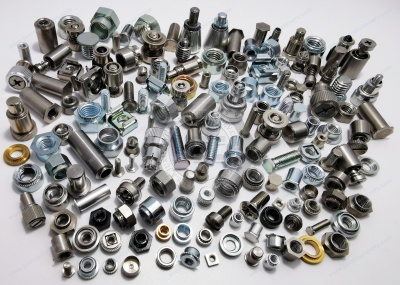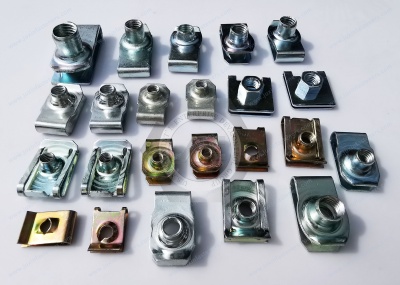Call Us
+86 136 6007 9809
Call Us
+86 136 6007 9809
Aug. 08, 2024
The structure of threaded fasteners for automotive manufacturing and the use of characteristic solutions
Threaded fasteners are the devices that connect the components of an automobile and are the parts that automotive repair technicians come in contact with the most, with hundreds of fasteners used in modern cars.
Fasteners used in cars include but are not limited to, the following types.
Washers: Washers are a kind of fasteners with a flat circular shape, placed between the support surface of bolts, screws, or nuts and the surface of the connected parts, used to increase the contact surface area of the connected parts, reduce the Unit area pressure, to protect the surface of the connected parts from damage. Washers and elastic washers are used to prevent the nut from loose.
Retaining rings: Retaining rings prevent the parts on the shaft or hole from moving from side to side and are usually installed in the shaft groove or hole groove of machines and equipment.
Pins: Pins are used primarily for locating parts but also for connecting and securing parts, transmitting power, or locking other fasteners.
Rivet: rivets by the head and nail rod composed of two parts, used to fasten the connection between two parts with a through-hole (or components) so that it becomes a whole piece belonging to the non-detachable connection
Combination of parts and connecting vice: Combination of parts refers to the combination of a class of fasteners supplied, such as some machine screws (or bolts, self-supporting screws) and flat washers (or spring washers, lock washers) combination of supplies. The combination of machine screws (or bolts, self-supporting screws) and flat washers (or spring washers, lock washers); coConnectionice refers to the combination of special bolts, nuts, and washers for the supply of a class of fasteners, such as high-strength large hexagonal bolts for structural steel connecting vice.
Weld nails: weld nails by the light energy and nail head (or no nail head) constitute, through the welding method, a fixed connection a part (or component) above to connect with other parts. To then connect with different parts.
Bolt: Bolt by the head and screw (cylinder with external threads), two parts, need to be used in conjunction with the nut, used to fasten the connection of the two parts with a through-hole.
Stud: The stud has no head but only two ends with external threads used to connect two parts to make a whole.
Nut: nut with internally threaded holes, the shape of the general flat hexagonal column, with the bolt, stud, or machine screws used for fastening the coConnectionetween the two parts. These fasteners play an essential role in the manufacture and maintenance of automobiles, ensuring that the various components of the vehicle can be firmly connected to ensure the safety and reliability of the car!
Definition and Classification of Threaded Fasteners
The most common fasteners for automotive components are shown in Figure 1, and the force caused on the bolt when it is tightened is shown in Figure 2, with the force acting on the fastener being the clamping force. The commonly used thread standard is the metric thread; a small number of imported cars from the United States and the United Kingdom may use the inch system thread (UNC, UNF), in addition to the car part of the sensors and screw plugs are also used in the cylindrical pipe threads and conical pipe threads.


Precautions for the use of threaded fasteners
1. Different thread types should not be used in place of each other; otherwise, it will lead to thread damage. To prevent damage to the fasteners, threaded fasteners must be assembled by hand (or finger) to tighten the first 3 to 5 turns of the bolt or nut. Otherwise, it is likely to cause damage.
2. According to the direction of bolts and nuts when screwing in, they are divided into right-hand and left-hand threads, but left-hand threads are not commonly used and have the letter "L" printed on them, while right-hand threads are most widely used. Right-hand threads are tightened by clockwise rotation (right-hand threads are tightened, left-hand threads are loosened), and left-hand threads are tightened by counterclockwise rotation.
3. Using a predetermined tightening torque is the most common method of controlling fastener tension. Axial tension is proportional to the torque applied under certain conditions, the most common of which is clean, dry, well-formed threads. In this case, friction on the thread consumes 40% of the torque used, friction between the head of the bolt and the mating surfaces uses 50% of the torque, and the remaining 10% is used to tighten the bolt. The friction is highest on dry surfaces and decreases when the fasteners are coated with lubricant.
4. Note that the torque specified in the service manual for tightening threaded parts refers to clean and oil-free conditions. Even when tightened to the specified torque, oily threaded parts may have unstable or insufficient clamping force on the part. Therefore, unless specified in the service manual, the torque refers to dry, clean threads.
Strength grade of fasteners
The performance grades of fasteners for bolts for steel connections are divided into more than 10 grades such as 3.6, 4.6, 4.8, 5.8, 6.8, 8.8, 9.8, 10.8, 12.9, etc., as shown in Figure 3. Grade 8.8 or higher metric fasteners must be marked 8.8 and above the material of the bolt for low-carbon alloy steel or medium-carbon steel and heat-treated (quenched, tempered), commonly known as high-strength bolts, and the rest of the widely known as ordinary bolts.
Metric Alloy Steel Hex Drive Flat Head Screws: Made from alloy steel, these screws are nearly twice as strong as stainless steel flat head screws. They're angled under the head to sit flush within countersunk holes. Length is measured from the top of the head.
Black-oxide alloy steel screws have mild corrosion resistance in dry environments.
Zinc-plated alloy steel screws resist corrosion in wet environments. Screws with a blue-dyed finish have a distinctive blue color that makes them easy to identify.
Alloy Steel Button Head Hex Drive Screws: Made from alloy steel, these screws are nearly twice as strong as stainless steel button head screws. Length is measured from under the head.
Black-oxide alloy steel screws are mildly corrosion-resistant in dry environments.
Zinc-plated alloy steel screws resist corrosion in wet environments.
Alloy Steel Button Head Torx Screws: Made from alloy steel, these screws are three times stronger than standard steel button head Torx screws. A Torx-Plus drive has more points of contact than other drives, allowing you to tighten the screw without damaging the recess. For Torx tools, see Torx and Torx-Plus bits, keys, and drivers. Torx-Plus screws can be used with both Torx-Plus and Torx tools. Length is measured from under the head.
Black-oxide alloy steel screws are mildly corrosion-resistant in dry environments.
Zinc-plated alloy steel screws resist corrosion in wet environments.
Alloy Steel Flanged Button Head Screws: Made from alloy steel, these screws are nearly twice as strong as stainless steel button head screws. They have a flange that distributes pressure across a wide surface, eliminating the need for a separate washer. Head height includes the flange. Length is measured from under the flange.
Black-oxide alloy steel screws are mildly corrosion-resistant in dry environments.
Zinc-plated alloy steel screws resist corrosion in wet environments.
For high-quality Metric Alloy Steel Hex Drive Flat Head Screws and professional technical support, please get in touch with us at adelajonly@gmail.com or visit our website at https://www.juxinfasteners.com.
Contact Us
Tel.:
+86 020 8621 0320
+86 020 3121 6067
Technical Support:
Navigation
SEND INQUIREY